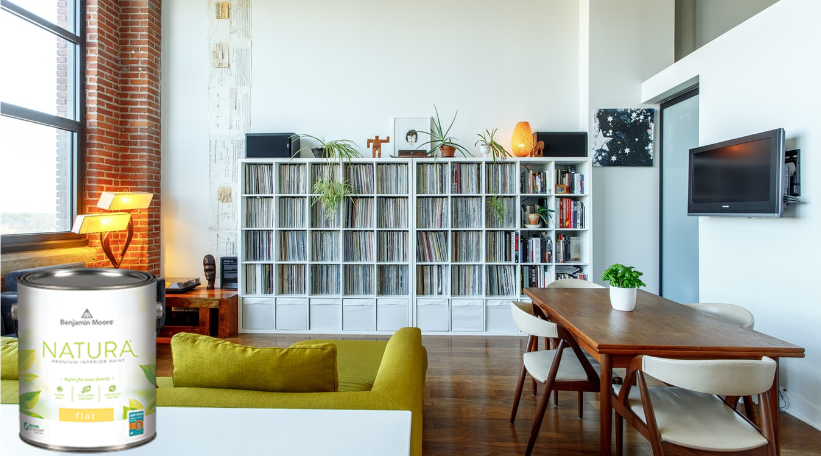The new year can be your greenest yet with so many eco-friendly products.
By Tammy Adamson-McMullen
If you’re considering a New Year’s resolution to go “greener,” you’ll have a lot of products to support it. This past year has ushered in many more environmentally friendly products in the decorating industry—and many of the already green products have gone even greener.
Paint and Coating Products
There are so many low- and zero-VOC (volatile organic compound) paints, stains, sealers and other coatings on the market that it’s hard not to be “green” in this category. As a refresher, VOCs are unstable compounds that release as vapors into the environment and then mix with other elements to create ozone, which causes pollution and health problems. In addressing this problem, the paint industry has produced a wide range of low- and zero-VOC products that not only are eco-friendly but that also produce fantastic results. These coatings are easy to apply, self-leveling and durable and dry to a hard finish. And, of course, they are low in odor, too.
Just when you think the products couldn’t get any better, they continue to evolve. An example is a major brand of no-VOC coatings that was reformulated several years ago with special technologies that actually eliminate other odors in the home. More recently, the line was reformulated once again with even newer technologies that improve indoor air quality by decreasing VOCs from other household products. Improvements like this are moving paint and coatings to a new level of “green,” which will be fascinating to watch in the coming years.
Paint Thinners and Strippers
This category is full of low-VOC products with improved performance characteristics that remove both oil- and latex-based coatings. The products are available in odorless, non-caustic, water-based formulations, some with soy or citrus additives and with the added benefit of being biodegradable. Like their more caustic counterparts, eco-friendly thinners and strippers remove paint, varnish, lacquer, adhesives and more but are safer for humans and the environment. Thinners and strippers are available in a wide range of sizes; to avoid having to store any excess, buy only what you need.
Carpets
You may be surprised to learn that carpets also can have VOCs—a byproduct of the latex binder used to secure fibers to the backing. However, as with paints, there are low-VOC products options available.
One way to ensure your carpet is low in VOCs is to look for a label by the Carpet and Rug Institute’s (CRI) Air Quality testing program, ensuring that the carpet has passed low-emissions standards. To further enhance the eco-friendliness of your carpet installation, ask contractors to use a non-solvent adhesive to glue down the carpet and opt for felt pads over those made from styrene-butadiene rubber. Felt pads not only are eco-friendly but also improved to hold up over time.
As for the carpet itself, try to choose natural, renewable materials that require fewer chemicals in their manufacture. Good candidates are organic wool, organic cotton, jute, sisal, seagrass and coir.
Wood Flooring
While it’s true that wood is a natural resource, some wood floors are “greener” than others. Examples include bamboo, a grass plant that is replenished without replanting. It also is grown without fertilizer and pesticides and, according to some sources, leaves the soil more enriched after it’s harvested. Other eco-friendly options include:
- reclaimed woods that have been used previously;
- wood resourced from plantations that have been certified by the Forest Stewardship Council, meaning they have adhered to sustainable forestry practices;
- cork, a byproduct of tree bark that is harvested from standing trees and which has antimicrobial and hypoallergenic qualities; and
- pine, which grows more quickly than other deciduous trees.
Household Cleaners
The past year was a prodigious one for environmentally friendly household cleaners. Many not only are bleach-free but also made with “soft chemicals,” meaning they have technologies that avoid harsh solvents and other fume-emitters. Some of the hottest products in 2018 have plant-derived ingredients and/or essentials oils. When possible, opt for cleaning products with baking soda, white vinegar, citrus extracts and similar natural agents.
Packaging
As you try to be a good steward in 2019, it’s important to think about your entire environmental footprint—from the moment you purchase a product until you dispose of its container. When possible, try to buy products that have biodegradable or recyclable packaging or that come in reusable or refillable containers. (If your product packaging can be recycled, make sure you follow your local jurisdiction’s regulations in recycling it properly.)

 Interior Paints
Interior Paints Exterior Paints
Exterior Paints Primers
Primers Stains & Clears
Stains & Clears
 Paint Brushes
Paint Brushes Paint Roller
Paint Roller Paint Trays & Liners
Paint Trays & Liners
